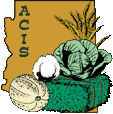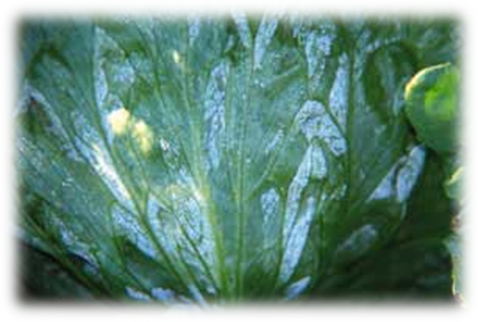
|
|
|
|

|
|||
|
|
|||
|
|
|||
|
Pest control advisors reported recently that downy mildew had become more prevalent
in Yuma Valley lettuce fields. This may seem surprising since very little rainfall
has occurred in the area. However, as mentioned in an earlier article, rainfall
is not an absolute requirement for downy mildew development. Spores of the lettuce
downy mildew pathogen form at night when the relative humidity in the leaf canopy
is near or at 100%. Ample water is supplied through irrigation to create high humidity
conditions and facilitate dew formation in the lettuce canopy as the crop develops.
Calm evenings with little or no wind also favor spore production by allowing humid
air to remain in the leaf canopy. Data from AZMET weather stations at the UA Yuma
Agricultural Center and in the South Yuma Valley show that the average wind speed
during January and February this year was 3.9 compared to 5.2 M.P.H. during the
same time period in 2013. Also, the mean air temperature during these months was
59°F this year compared to 54°F in 2013. The latent period (the time from spore
infection of leaf to first appearance of leaf lesion and beginning of spore production)
ranges from 4 to 7 days at temperatures of 68 to 72°F and 24 to 34 days at 42°F.
The increased temperatures recorded this year compared to 2013 would favor a shortened
latent period, resulting in more cycles of infection and sporulation and a faster
rate of disease development. Another factor affecting downy mildew severity is the
genetic resistance or tolerance (or lack thereof) of the lettuce cultivars in fields
at this time. Several factors impact the final severity of downy mildew in any given
lettuce planting; however, air movement and temperature recorded in January and
February of this year were more favorable to downy mildew development compared to
the same months in 2013.

To contact Mike Matheron go to: matheron@ag.arizona.edu.
|
|||
| Back | |||
|
For questions or comments on any of the topics please contact Marco Pena at the Yuma Agricultural Center.
|
|||
|
Home |
Cotton | Veggies |
Forages | Grains
| Citrus |
Crop x Crop Insects | Diseases| Weeds | Pesticides | Economics | News | Weather | Research | Photos | Contacts | General Info. Copyright © 2001 University of Arizona, College of Agriculture and Life Sciences Webmaster: Al Fournier (acis@ag.arizona.edu) |
|||
